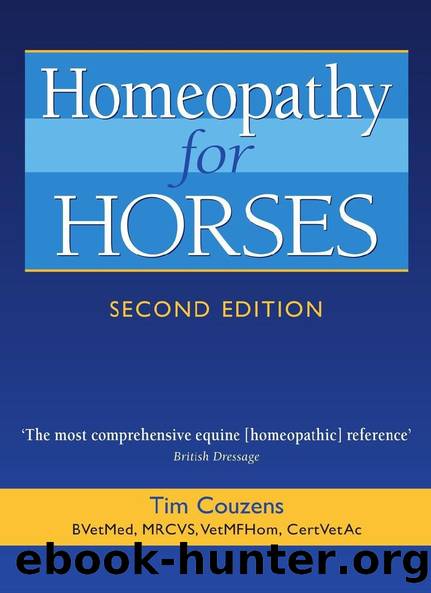Homeopathy for Horses by Couzens Tim

Author:Couzens, Tim
Language: eng
Format: epub
Publisher: Quiller
Published: 2011-07-18T23:00:00+00:00
The Endocrine System
The endocrine or hormonal system controls some of the major functions of the body through a number of chemical intermediaries or chemical messengers referred to as hormones. These are produced and secreted by a number of glands and circulate in the blood to their target organs. Hormones, for example, control the oestrus cycle, influence hair growth, maintain blood sugar levels and regulate metabolism. Endocrine problems are relatively rare in the horse. The most common condition is Cushing’s disease but on occasion diabetes mellitus, diabetes insipidus and hypothyroidism may be seen.
Cushing’s Disease Hyperadrenocorticism
Cushing’s disease is named after an American surgeon, Harvey Cushing, who first described the condition in people in 1932 whilst researching the brain and function of the pituitary gland. Mainly seen in older horses, it has been diagnosed in horses as young as seven.
Symptoms arise due to high levels of the hormone cortisol circulating in the blood secreted by the adrenal glands which are located near the kidneys. Cortisol secretion is governed by a hormone known as adrenocorticotrophic hormone (ACTH), which is produced by the tiny pituitary gland, located near the base of the brain. Cushing’s disease develops when the gland develops cancerous changes. Classified as a pituitary adenoma (sometimes referred to as pituitary hyperplasia or adenomatous hypertrophy of the pars intermedia of the pituitary gland), this slow growing, benign tumour secretes excess quantities of ACTH which in turn causes excess production of cortisol by the adrenal glands. The stable balance between the pituitary gland and the adrenal gland (together with a closely linked area of the brain known as the hypothalamus) normally maintained and regulated by a negative feedback mechanism, is no longer stable. The effects on the body of the excess cortisol are varied and include an anti-insulin action, an increase in blood glucose level (caused by stimulating the liver to break down stored protein) and constriction of blood vessels (vasoconstriction).
One of the earliest symptoms is an increase in thirst (polydipsia) and consequently an increase in urination (polyuria), signs often difficult to spot in animals kept outside. Other signs are more obvious. One of the most common is retention of the long, shaggy winter coat, which is not shed in the spring or summer as normal and an increase in the rate of growth of the coat (hirsuitism) which often appears unusually curly. These can often be the first symptoms to be noticed and may be accompanied by a tendency to sweat more (hyperhydrosis).
Other symptoms include an increase in appetite without weight gain and often with some slight loss of condition especially over the topline and the development of laminitis which can become a recurrent problem. Affected horses will also have a weakened immune system, which can lead to a variety of problems such as abscesses, skin and respiratory infections, ulcers within the mouth and slow wound healing. Less commonly seen symptoms include abnormal oestrus cycles and milk production in mares, general lethargy, depression, heavy parasite burdens, the appearance of supra orbital fat deposits – bulges over the eyes and of fat pads elsewhere over the body.
Download
This site does not store any files on its server. We only index and link to content provided by other sites. Please contact the content providers to delete copyright contents if any and email us, we'll remove relevant links or contents immediately.
| Riding | Showing & Training |
Finding Gobi by Dion Leonard(2259)
Grumpy Cat by Grumpy Cat(2119)
The Silkworm by Robert Galbraith(1999)
A New Earth: Awakening to Your Life's Purpose by Eckhart Tolle(1974)
End of Days by Sylvia Browne(1823)
Tippi by Tippi Hedren(1765)
Total Cat Mojo by Jackson Galaxy(1688)
Backyard Chickens Beyond the Basics by Pam Freeman(1618)
The Animals Among Us by John Bradshaw(1508)
The Ultimate Pet Health Guide by Gary Richter(1431)
Vet in Harness by James Herriot(1387)
Cesar's Way by Cesar Millan(1366)
Dog Years by Mark Doty(1365)
Doggy Desserts: 125 Homemade Treats for Happy, Healthy Dogs by Cheryl Gianfrancesco(1359)
All Things Bright and Beautiful by James Herriot(1304)
Chicken Soup for the Ocean Lover's Soul by Jack Canfield(1289)
Walking with Peety by Eric O'Grey(1286)
Dog Training 101 by Kyra Sundance(1262)
Encyclopedia of Dog Breeds by D. Caroline Coile Ph.D(1178)
